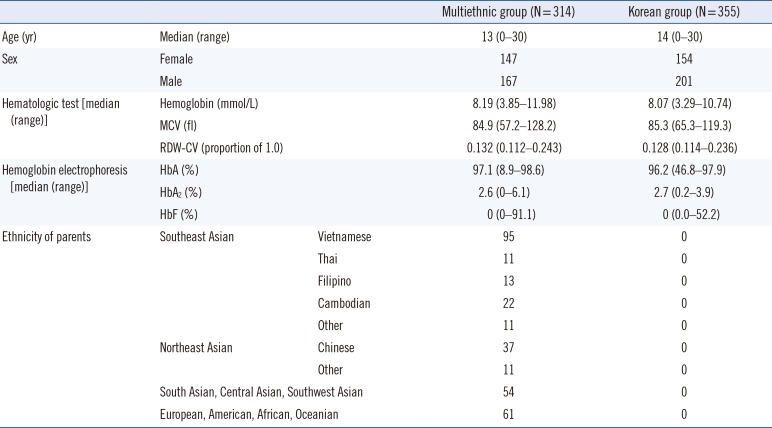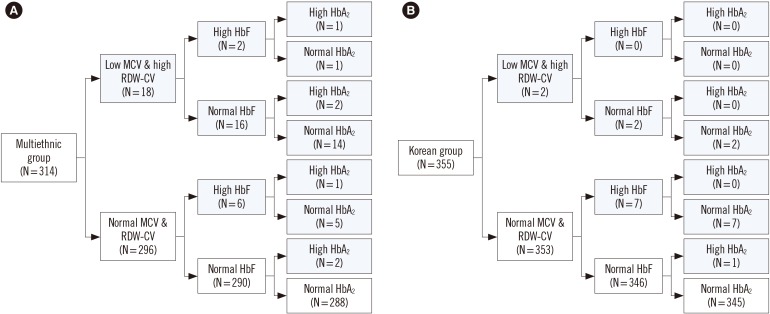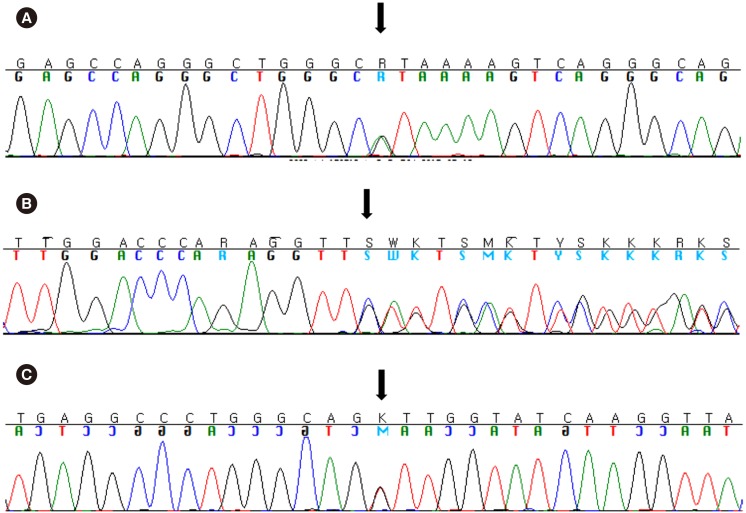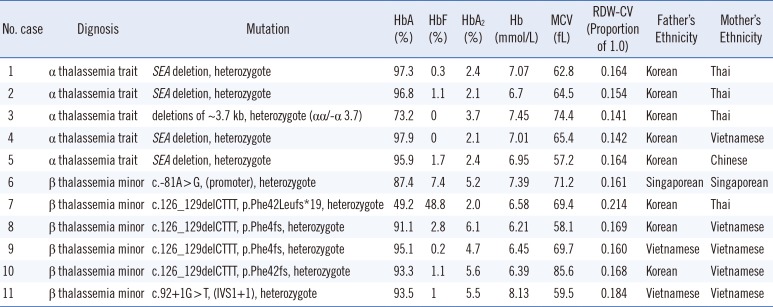1. Li CK. New trend in the epidemiology of thalassaemia. Best Pract Res Clin Obstet Gynaecol. 2017; 39:16–26. PMID:
27847257.
2. De Sanctis V, Kattamis C, Canatan D, Soliman AT, Elsedfy H, Karimi M, et al. β-Thalassemia distribution in the Old World: an ancient disease seen from a historical standpoint. Mediterr J Hematol Infect Dis. 2017; 9:e2017018. PMID:
28293406.
3. Hossain MS, Raheem E, Sultana TA, Ferdous S, Nahar N, Islam S, et al. Thalassemias in South Asia: clinical lessons learnt from Bangladesh. Orphanet J Rare Dis. 2017; 12:93. PMID:
28521805.
4. Lai K, Huang G, Su L, He Y. The prevalence of thalassemia in mainland China: evidence from epidemiological surveys. Sci Rep. 2017; 7:920. PMID:
28424478.
5. Modell B, Darlison M. Global epidemiology of haemoglobin disorders and derived service indicators. Bull World Health Organ. 2008; 86:480–487. PMID:
18568278.
6. Park ES, Jung HL, Kim HJ, Park SS, Bae SH, Shin HY, et al. Hereditary hemolytic anemia in Korea from 2007 to 2011: a study by the Korean Hereditary Hemolytic Anemia Working Party of the Korean Society of Hematology. Blood Res. 2013; 48:211–216. PMID:
24086942.
7. Korean Ministry of Justice. Statistical yearbook of foreign policy on immigration in 2017. Updated on Jun 2018.
http://www.moj.go.kr.
8. Mosca A, Paleari R, Leone D, Ivaldi G. The relevance of hemoglobin F measurement in the diagnosis of thalassemias and related hemoglobinopathies. Clin Biochem. 2009; 42:1797–1801. PMID:
19580798.
9. Patrinos GP, Giardine B, Riemer C, Miller W, Chui DH, Anagnou NP, et al. Improvements in the HbVar database of human hemoglobin variants and thalassemia mutations for population and sequence variation studies. Nucleic Acids Res. 2004; 32:D537–D541. PMID:
14681476.
10. O’Riordan S, Hien TT, Miles K, Allen A, Quyen NN, Hung NQ, et al. Large scale screening for haemoglobin disorders in southern Vietnam: implications for avoidance and management. Br J Haematol. 2010; 150:359–364. PMID:
20497177.
11. Nuinoon M, Kruachan K, Sengking W, Horpet D, Sungyuan U. Thalassemia and hemoglobin E in Southern Thai blood donors. Adv Hematol. 2014; 2014:932306. PMID:
25050123.
12. Kohne E. Hemoglobinopathies: clinical manifestations, diagnosis, and treatment. Dtsch Arztebl Int. 2011; 108:532–540. PMID:
21886666.
13. Sayani FA, Kwiatkowski JL. Increasing prevalence of thalassemia in America: implications for primary care. Ann Med. 2015; 47:592–604. PMID:
26541064.
14. Mettananda S, Higgs DR. Molecular basis and genetic modifiers of thalassemia. Hematol Oncol Clin North Am. 2018; 32:177–191. PMID:
29458725.
15. Lithanatudom P, Khampan P, Smith DR, Svasti S, Fucharoen S, Kangwanpong D, et al. The prevalence of alpha-thalassemia amongst Tai and Mon-Khmer ethnic groups residing in northern Thailand: a population-based study. Hematology. 2016; 21:480–485. PMID:
27077764.
16. Yamashiro Y, Hattori Y. Hemoglobinopathies in Japan: characteristics and comparison with those of other ethnic groups. Rinsho Ketsueki. 2015; 56:752–759. PMID:
26251137.
17. Hong CR, Kang HJ, Lee JW, Kim H, Kim NH, Park KD, et al. Clinical characteristics of pediatric thalassemia in Korea: a single institute experience. J Korean Med Sci. 2013; 28:1645–1649. PMID:
24265529.
18. Torcharus K, Sriphaisal T, Krutvecho T, Ketupanya A, Vuthiwong C, Suwanasophon C, et al. Prenatal diagnosis of Hb Bart’s hydrops fetalis by PCR technique: Pramongkutklao experience. Southeast Asian J Trop Med Public Health. 1995; 26 Suppl 1:287–290. PMID:
8629126.
19. Filon D, Oppenheim A, Rachmilewitz EA, Kot R, Truc DB. Molecular analysis of beta-thalassemia in Vietnam. Hemoglobin. 2000; 24:99–104. PMID:
10870880.
20. Svasti S, Hieu TM, Munkongdee T, Winichagoon P, Van Be T, Van Binh T, et al. Molecular analysis of beta-thalassemia in South Vietnam. Am J Hematol. 2002; 71:85–88. PMID:
12353305.
21. Huang H, Xu L, Lin N, He D, Li Y, Guo D, et al. Molecular spectrum of β-thalassemia in Fujian Province, Southeastern China. Hemoglobin. 2013; 37:343–350. PMID:
23682686.
22. Yu X, Yang LY, Yang HT, Liu CG, Cao DC, Shen W, et al. Molecular epidemiological investigation of thalassemia in the Chengdu region, Sichuan Province, southwest China. Hemoglobin. 2015; 39:393–397. PMID:
26290351.
23. Boonyawat B, Monsereenusorn C, Traivaree C. Molecular analysis of beta-globin gene mutations among Thai beta-thalassemia children: results from a single center study. Appl Clin Genet. 2014; 7:253–258. PMID:
25525381.
24. Park SS. Beta-thalassemia in the Korean population. Int J Hematol. 2002; 76 Suppl 2:93–95. PMID:
12430907.
27. Angelucci E, Matthes-Martin S, Baronciani D, Bernaudin F, Bonanomi S, Cappellini MD, et al. Hematopoietic stem cell transplantation in thalassemia major and sickle cell disease: indications and management recommendations from an international expert panel. Haematologica. 2014; 99:811–820. PMID:
24790059.
28. Algiraigri AH, Wright NAM, Paolucci EO, Kassam A. Hydroxyurea for nontransfusion-dependent β-thalassemia: a systematic review and meta-analysis. Hematol Oncol Stem Cell Ther. 2017; 10:116–125. PMID:
28408107.
29. Srivastava A, Shaji RV. Cure for thalassemia major–from allogeneic hematopoietic stem cell transplantation to gene therapy. Haematologica. 2017; 102:214–223. PMID:
27909215.
30. Ferrari G, Cavazzana M, Mavilio F. Gene therapy approaches to hemoglobinopathies. Hematol Oncol Clin North Am. 2017; 31:835–852. PMID:
28895851.
31. de Dreuzy E, Bhukhai K, Leboulch P, Payen E. Current and future alternative therapies for beta-thalassemia major. Biomed J. 2016; 39:24–38. PMID:
27105596.
32. Rachmilewitz EA. How I treat thalassemia. Blood. 2011; 118:3479–3488. PMID:
21813448.
33. Neufeld EJ. Oral chelators deferasirox and deferiprone for transfusional iron overload in thalassemia major: new data, new questions. Blood. 2006; 107:3436–3441. PMID:
16627763.
34. Quinn CT, St Pierre TG. MRI measurements of iron load in transfusion-dependent patients: implementation, challenges, and pitfalls. Pediatr Blood Cancer. 2016; 63:773–780. PMID:
26713769.
35. Lee HJ, Shin KH, Kim HH, Kim MJ, Kim JN. A survey of the opinions of transfusion specialists on transfusion policy of thalassemia patients in Korea. Korean J Blood Transfus. 2017; 28:282–289.
36. Humphreys JV. The management of sickle cell disease in a primary care setting. J Family Med Prim Care. 2012; 1:56–58. PMID:
24479003.
37. Cunningham MJ. Update on thalassemia: clinical care and complications. Pediatr Clin North Am. 2008; 55:447–460. PMID:
18381095.










 PDF
PDF ePub
ePub Citation
Citation Print
Print



 XML Download
XML Download